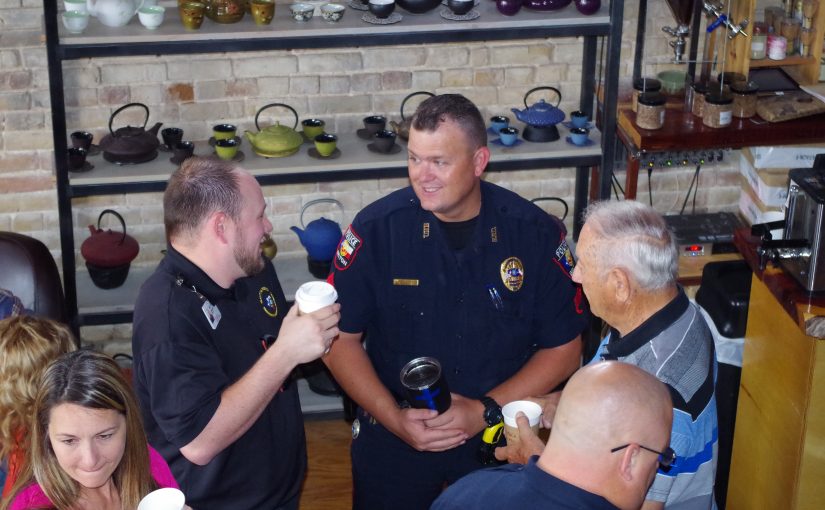In 2011, Hawthorne, California, Police Chief Robert Fager realized that his officers needed a more personal and engaging way to communicate with the residents in the city. Tired of the traditional Q & A and “town hall” meeting concepts, he asked the agency’s newly created Community Affairs Unit to come up with a new concept to encourage positive community-police interactions.
The result, the first Coffee with a Cop, was held at a local McDonald’s and was an immediate success. The program focused on creating a neutral space and having officers engage community members in one-on-one conversations with “no agenda and no speeches.” In effect, it turned the tired town hall meeting model on its head—officers talked with community members instead of at them.
Coffee with a Cop works because it’s simple. Coffee with a Cop creates an atmosphere that facilitates communication by breaking down the traditional barriers that so often exist between police officers and the people whom they serve.
Coffee with a Cop events create a relaxed, neutral atmosphere with no speeches, no agenda, and no preset subjects. They allow residents to sit down with the local officers that patrol their community and give the community member
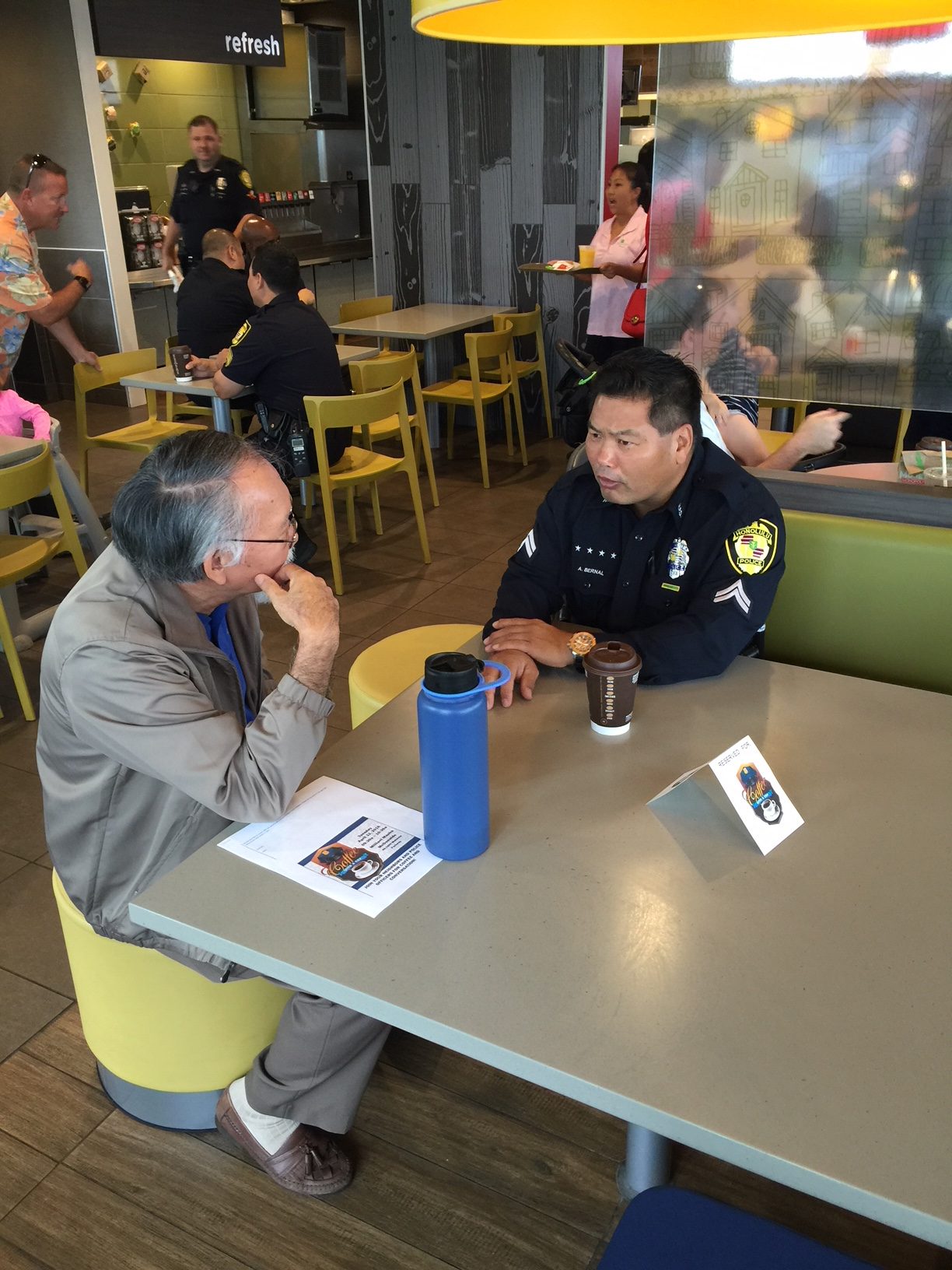
s the ability to discuss the concerns that are most important to them. The conversations are intimate and personal, important to both the residents and the officers speaking with them.
Coffee with a Cop provides “faces” for officers and community members to connect with to encourage them to get to know each other and form a working trust based on their mutual goal—a better, safer community. Coffee with a Cop provides distraction-free time with an officer—no pending radio calls or cellphones ringing—just good communication.
Growth of the Program
In 2012, the Office of Community Policing Services (COPS Office) awarded the Hawthorne Police Department and the University of Illinois Center for Public Safety and Justice a grant to help create a training curriculum and implement the Coffee with a Cop program across the United States.
The development of the curriculum included looking at the way law enforcement agencies traditionally communicated with the public and how it could be improved. One of the first things the curriculum developers noticed was the hesitation for many community members to speak with officers in a casual setting. The most common “barriers” were the uniform itself and the fact that people didn’t always feel that their concerns were important enough for them to “bother” officers.
Cultural challenges were addressed as well during the program’s development. For instance, in the United States, preconceived notions of inapproachability based upon experiences with police in other countries was a real issue in immigrant and non-English speaking communities. The behavior of police officers in group settings was also addressed—police officers often formed clusters with each other (it was equated to gathering over a “hood of a patrol car”).This gave the impression that officers did not want to be approached or “bothered” by the public. This is often a safety or subconscious tactical maneuver by officers meant to help them “watch each other’s backs,” but it also gave the impression that the officers were “not open to non-officer interactions.”
The first Coffee with a Cop training course was held in Gulf Shores, Alabama, in 2013. The Gulf Shores Police Department had been the second agency to host a Coffee with a Cop event shortly after an article was published in 2012 in the COPS Office Dispatch.1 The attending officers from four surrounding states were initially hesitant and questioned why they needed to be “taught how to drink coffee.” The class focused on communication techniques as well as “lessons learned” from past Coffee with a Cop events.
Gulf Shores Chief of Police, Edward Delmore embraced the program from the beginning:
We were already doing a lot of the traditional labor–intensive and time–consuming community policing events like our citizens’ academy. We were looking for a different way to reach out to the citizens we serve, and we were in a unique situation.
Gulf Shores is an island in the Gulf of Mexico. The city has miles and miles of beautiful soft white sand beaches, and, as a result, we are primarily a tourist community. Especially in the winter time, half of our residents are snowbirds from the upper Midwest or Canada. These are great people who may know their officers where they live in Illinois or Michigan, but they didn’t know us—and they are spending months and months here every year. So, for us, Coffee with a Cop was a way to reach our long-term visitors and our permanent residents. It’s, without a doubt, given us the ability to make deposits into the so-called community trust bank and it continues to pay dividends.
On a regular basis, I have people approach me and say, “Hey, Chief, I met some of your officers at the coffee with a cop. They’re great!” The other thing is you’re not just involving a couple of officers. Over time, most of our sworn personnel have been at one of the events from the 20– or 30–year veterans all the way to the boots. Over the years since we began the program in 2012, we realized how many people we were reaching doing this when we weren’t taking a crime report or making a vehicle stop. It’s an interaction where everybody is in a good mood.2
The Coffee with a Cop class has now been taught more than 40 times in the United States, as well as in Montreal, Canada. It has been an eye opener for many officers who have attended, not quite knowing what to expect.
Rob Rodriguez, chief of police in Cordele, Georgia, shared his thoughts after Cordele Police Department’s very first Coffee with a Cop event on the program. He stated,
My initial thoughts were that of excitement. I watched my officers sitting there laughing and taking selfies with our citizens. I realized the positive impact that Coffee with a Cop was having on both our citizens as well as our officers. We will definitely be having another event; in fact, we are planning our next one now.3
Best Practices for Coffee with a Cop Events
Since the program’s origin in 2011, Coffee with a Cop has been refined by the Hawthorne Police Department and other agencies who host these events. Their lessons learned have contributed to a set of best practices for agencies seeking to host their own Coffee with a Cop events.
1. Pick the right location for your needs. Hawthorne learned through trial and error to pick those locations that serve food quickly, such as coffee houses and fast food restaurants. If the event is held in a traditional “sit-down” restaurant, it often takes too long for community members to be served, to eat, and then to talk. The events become too long and stagnant and can lead to awkward pauses, and officers can end up standing around with nobody to talk to. The use of police stations and other government facilities is also discouraged—a key component of Coffee with a Cop is that the events are held in a “neutral space.” A station or government building can be an obstacle for some members of the community who might not feel comfortable there, thus limiting the openness of the events. Consider what locations best fit your specific community and be creative—for example, the Gardena, California, Police Department recently held their event at an auto repair shop.
2. Have a designated ”host” who has the ability to coordinate the entire event. Rank should not matter as much as personality when selecting this individual, as this person will likely be the first person whom community members see when they arrive at the Coffee with a Cop event. The host needs to greet people and make sure officers don’t stand around without anyone to talk to. The host should be able to direct people who have specific questions to the appropriate officers. The host also acts as the liaison between the police and the location employees and management to ensure a successful event.
3. Pick the right officers to attend the first few events. There might be some pushback from officers who are less than enthusiastic about the whole idea of talking to people in a freeform setting. Agencies should include their “A team” of officers at first—officers who are friendly and approachable—as they will set the standard and expectations for future Coffee with a Cop events. The other, less-enthusiastic officers will eventually hear about how enjoyable the events are from officers who attended them and will end up attending events themselves. This is the beginning of the organizational transformation that often occurs as a result of the Coffee with a Cop program.
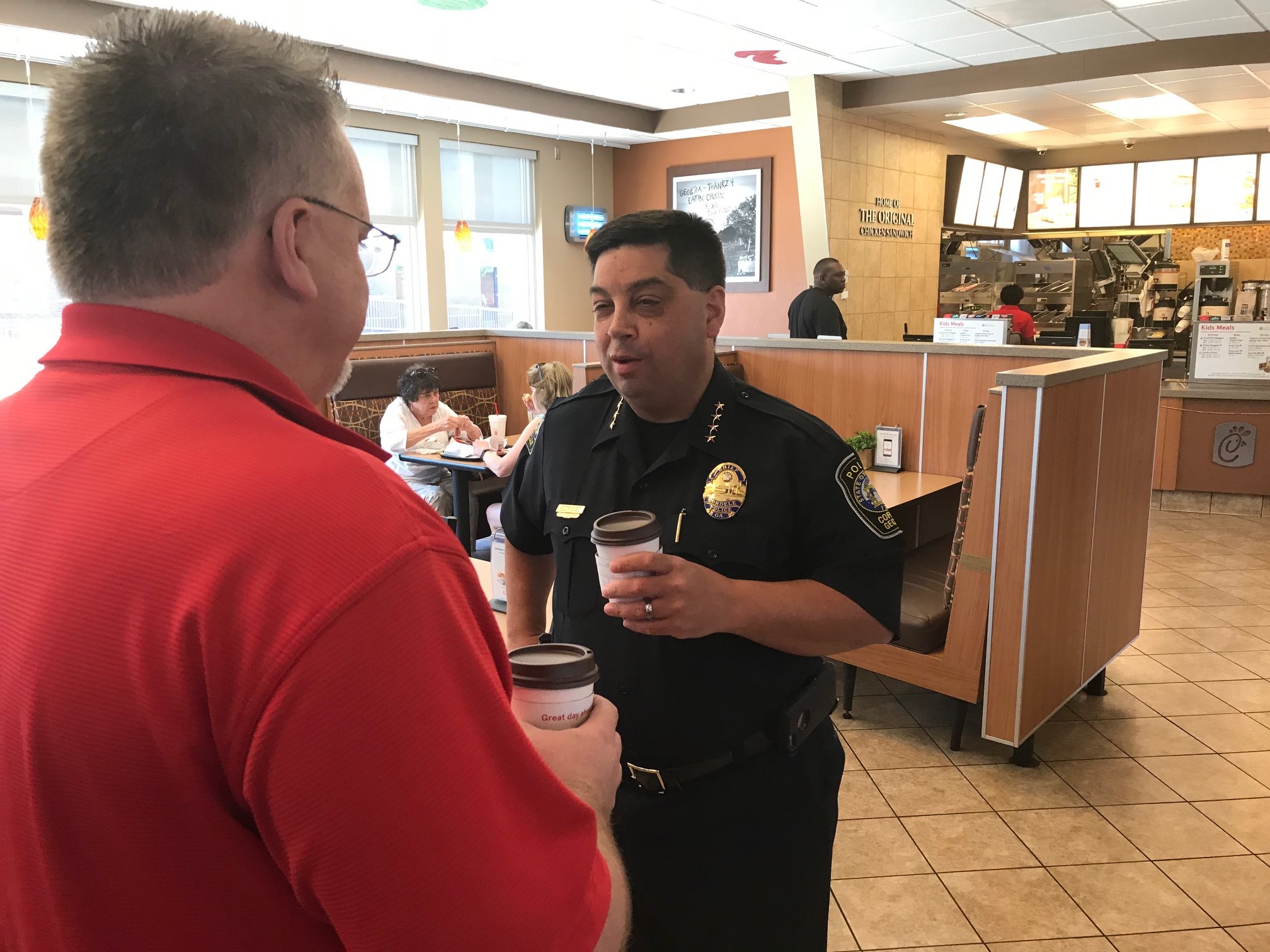
4. Do not have the event in a separate room at the selected location. This was one of the first issues to be identified. Superior, Wisconsin, Police Officer Bonnie Beste held her first event in late 2011 and reported back that they had the event in the back room of the fast food restaurant. The problem she kept running into was that people were afraid to enter the room with the officers because they thought it was a meeting or a private police event. She had to go to the main dining area and ensure people knew that the back room was indeed where Coffee with a Cop was being held. Try to have the event right in the main dining area; this location creates great opportunities for officers to engage community members who just came to eat and didn’t even realize there was an event going on. It’s often not about who is coming specifically for the event, but more about who is already there!
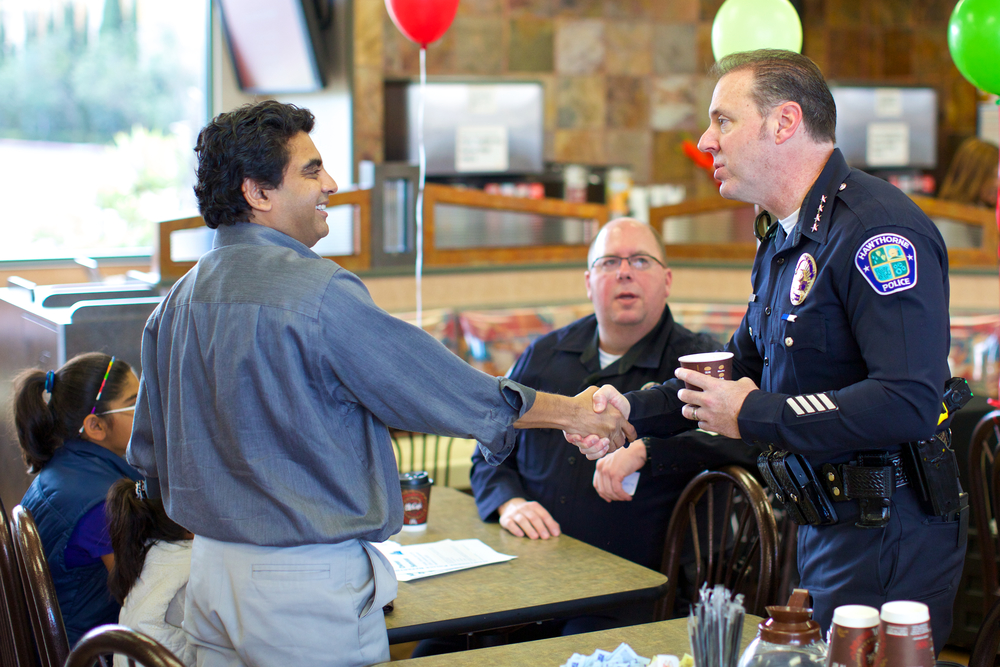
5. Advertise the event on social media, as well as posting flyers at the event location. The Coffee with a Cop website has templates for Instagram and Facebook flyers, as well as logos for departments to use. Social media is very easily shared, which helps spread the word more quickly and more widely. Feel free to get creative—perhaps use a smartphone and make a simple video to announce the upcoming event!
Also, consider the use of the flashing road signs, as some agencies have found that those work very well in getting the word out about the event. Put a flashing sign outside the location a few days prior, and watch the event attendance skyrocket.
6. Chiefs or high–ranking command staff should come late and leave early! The events are meant to help community members build relationships with line-level officers and supervisors—when the agency brass is there, they attract all the attention and detract from the real intent of Coffee with a Cop. The chiefs and other command staff should deal with politicians and other public figures, as well, during events.
The Future of the Coffee with a Cop Program
As of April 2018, the Coffee with a Cop program is now officially a nonprofit organization run by members of the Hawthorne Police Department in California along with key stakeholders from agencies across the United States, Australia, Canada, and Europe. 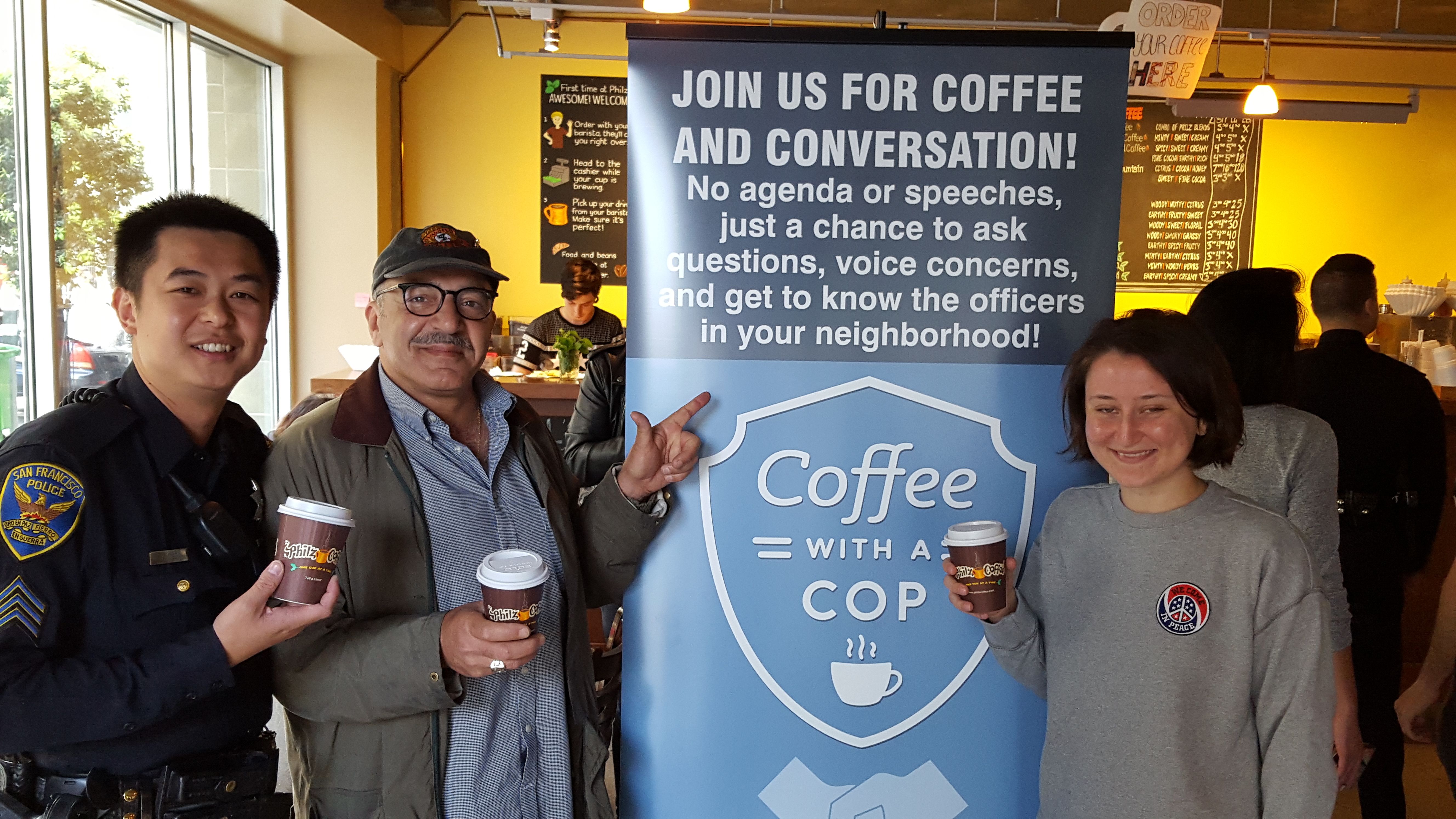
The mission of the nonprofit organization is to promote the Coffee with a Cop brand; maintain the program’s website, flyers, and logos; organize National Coffee with a Cop Day; and provide free Coffee with a Cop and Community Policing training workshops across the world.
Coffee with a Cop’s success is the direct result of public safety agencies worldwide adopting and believing in creating a community policing culture in order to build trust and relationships with the communities they serve.
So, what are you waiting for? Grab your officers, some good coffee—and start “building relationships one cup at a time!”
Notes:
1“Coffee with a Cop,” Dispatch 5, no. 1 (January 2012).
2Edward Delmore (chief of police, Gulf Shores Police Department), interview, July 2018.
3Rob Rodriguez (chief of police, Cordele Police Department), interview, July 2018.


